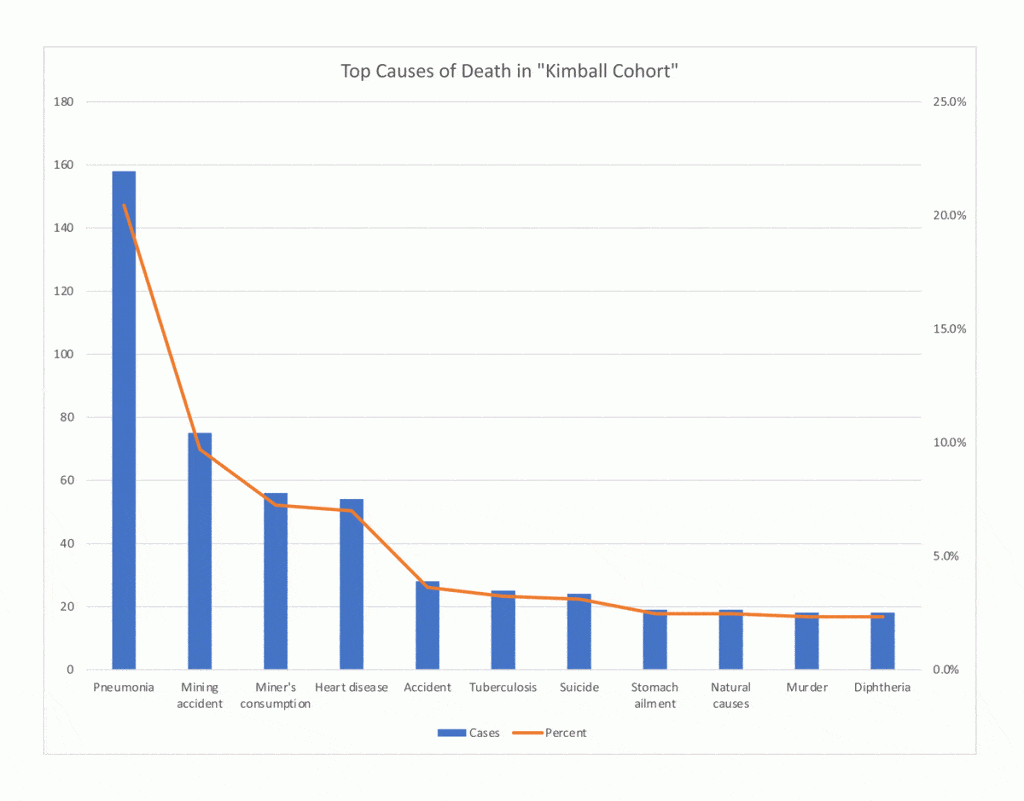In 2005, Park City historian Gary Kimball published a seminal work: “Death & Dying in Old Park City.” He spent 18 months researching newspaper obituaries and mortuary records, producing a 126-page listing of a thousand people who were buried in Park City from 1877 to 1954 and whose burials did not make it into cemetery records. There’s no narrative thread, just ‘core samples’ of woe paragraph by paragraph. “This is the story of the forgotten ones,” he wrote.
This article is a tabulation of those woes. It attempts to categorize some of the causes, genders, and ages of the people described in Kimball’s work. This is not a statistically comprehensive expression of all death by all causes with all demographic data in place, as you would expect from a state or research authority. Kimball’s record drew primarily from the Park Record, and there are many missing elements in terms of gender, age, cause of death, and even date of birth or death. Like a core sample, the data indicate trending strata, not a delineation of the full body of ore.
With caveats in place, what were the leading causes of death in the cohort described in “Death & Dying”?
Far and away, the leading killer is not dramatic. It was pneumonia. Of the 773 deaths in Kimball’s work that have sufficient data for our purposes, some 158 or 20.4 percent represent deaths by “the old man’s friend.” Back then pneumonia respected no age; Victims ranged from infants to those in their 70s. In Park City, pneumonia was a sweeping scythe that took many lives, decade after decade.
Numbers two and three among causes in the “Death & Dying” list reflect our mining heritage. Mining accidents represent 75 or nearly 10 percent of the researched deaths. These include falls, cave ins, cage mishaps, runaway ore carts, explosions, and more. The horrible lung-damaging ailment silicosis – or miner’s consumption – represents 56 (or more than 7 percent of) deaths. The takeaway? Mining yields nearly a fifth of the deaths in Kimball’s tally.

Credit: Graph created by Michael O’Malley
The number four killer in the cohort was heart disease. Compare this to 2017, when heart disease was Utah’s number one cause of death. The other top causes of death in “Death & Dying” round out with ailments that today’s medicine regards as addressable or controllable. These include non-mining accidents, tuberculosis, stomach ailments, diphtheria, and kidney failure. Of this list, only accidents are near the top of Utah’s contemporary list (number three statewide in 2017).
Life in old Park City had brutal edges. At 2.3 percent, murder consumed 18 lives, and suicide 3.1 percent or 24 lives. In possibly the most gruesome way to take one’s life, Samuel A. Johanson shoved a stick of black powder in his mouth, lit it, and the resulting explosion splattered his head onto the walls of the Ontario Mine in March 1925.
How did Park City’s experience align with the state as a whole? Picking 1910 as representative year, since that’s when statewide reporting gained relative robustness, Utah’s top causes of death were pneumonia (10.7 percent), injuries (8.5 percent), heart disease (7.4 percent), and kidney failure (5.9 percent). Other familiars – tuberculosis and typhoid – came in at 4.1 and 3.4 percent.
The question of life expectancy in Old Park City is tricky. Kimball’s book stretches more than seven decades in terms of the years of demise, with 1908 as the median point. Life expectancy for men in this collection averaged 35 years while women averaged 23 years. Not much weight can be put on this comparison but, nationally in 1908, life expectancy for men was about 48 years and for women about 52. Death during childbirth was a likely occurrence for both mothers and newborns. Approaching 30 percent, the large number of deaths of those two or under drives the Park City life expectancy numbers lower in both genders. Kimball describes the scale of infant mortality as “numbing.”
The lesson for today? In 2020, the top causes nationally were heart disease, cancer, COVID, accidents, and stroke, reflecting that people tend to live longer nowadays. We all owe a debt of gratitude to the scientists, doctors, nurses, public health officials, and other healthcare professionals who have cornered and caged diseases and ailments that terrified previous generations.
The Park City Museum is hosting an in-person lecture on historic preservation efforts in Park City by City Planner Aiden Lilly on Thursday, August 11 from 5 to 6 p.m. at their Education and Collections Center at 2079 Sidewinder Drive. Register here.